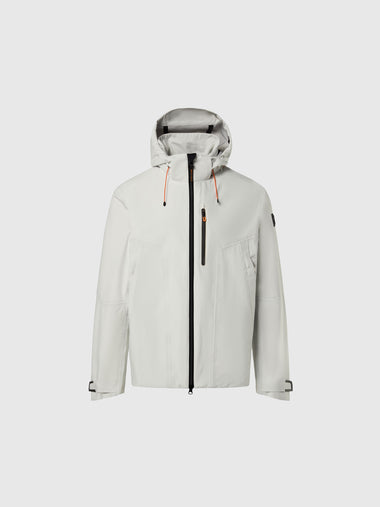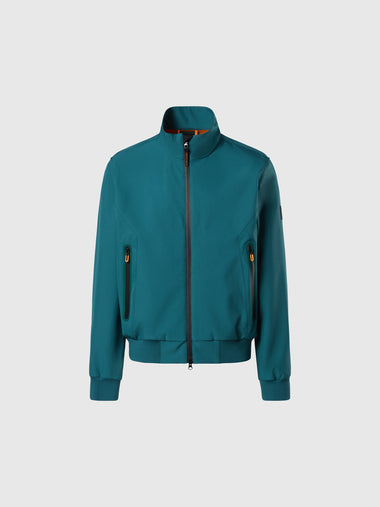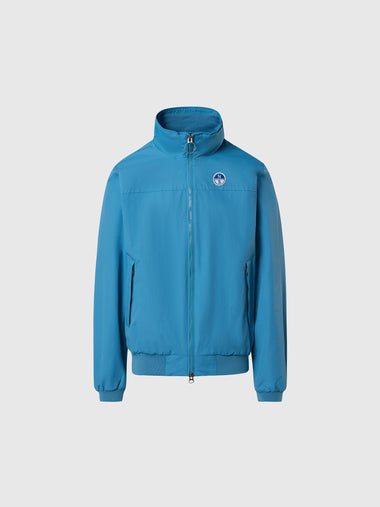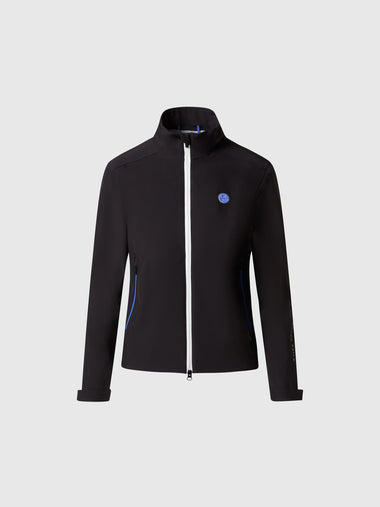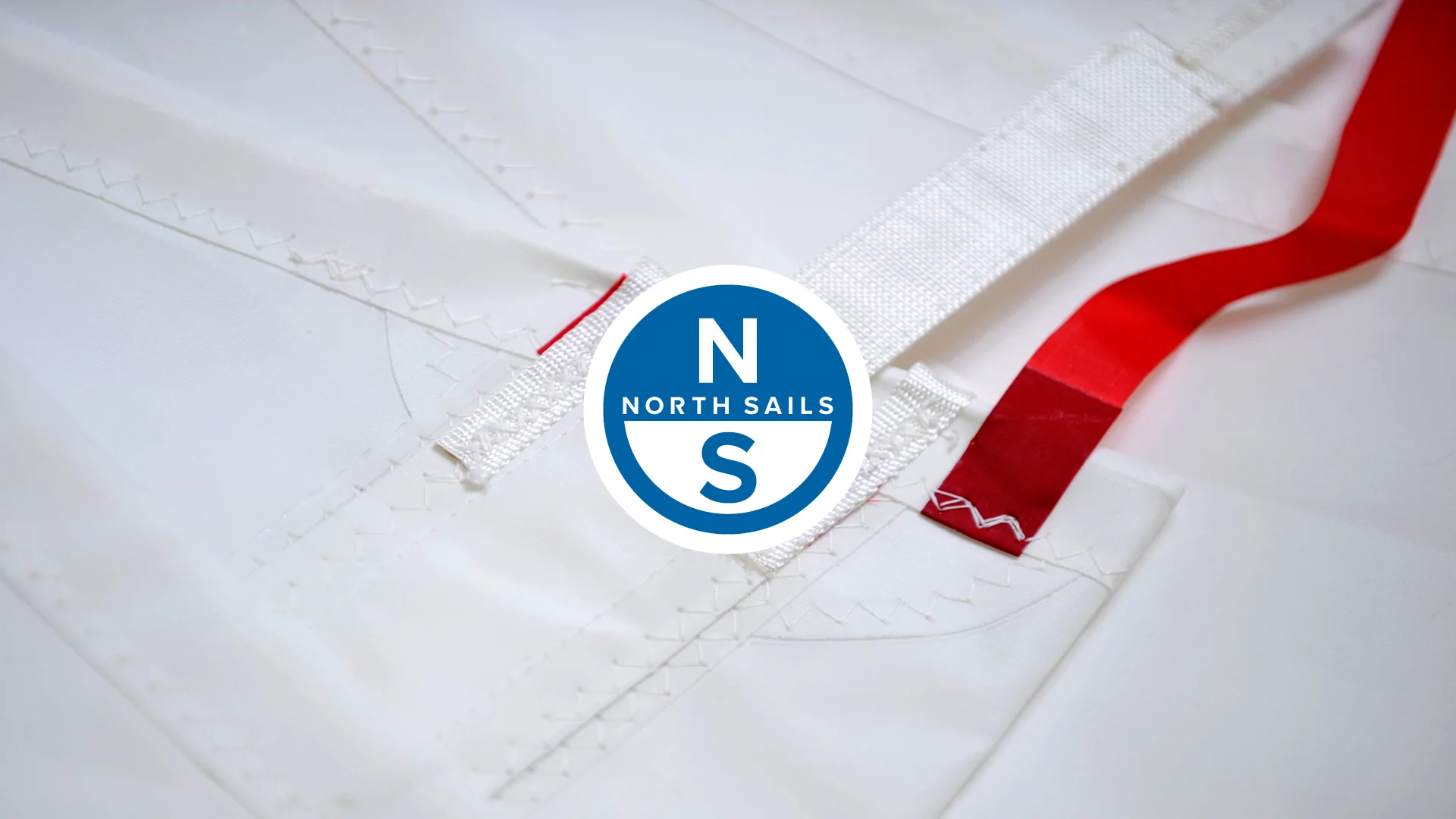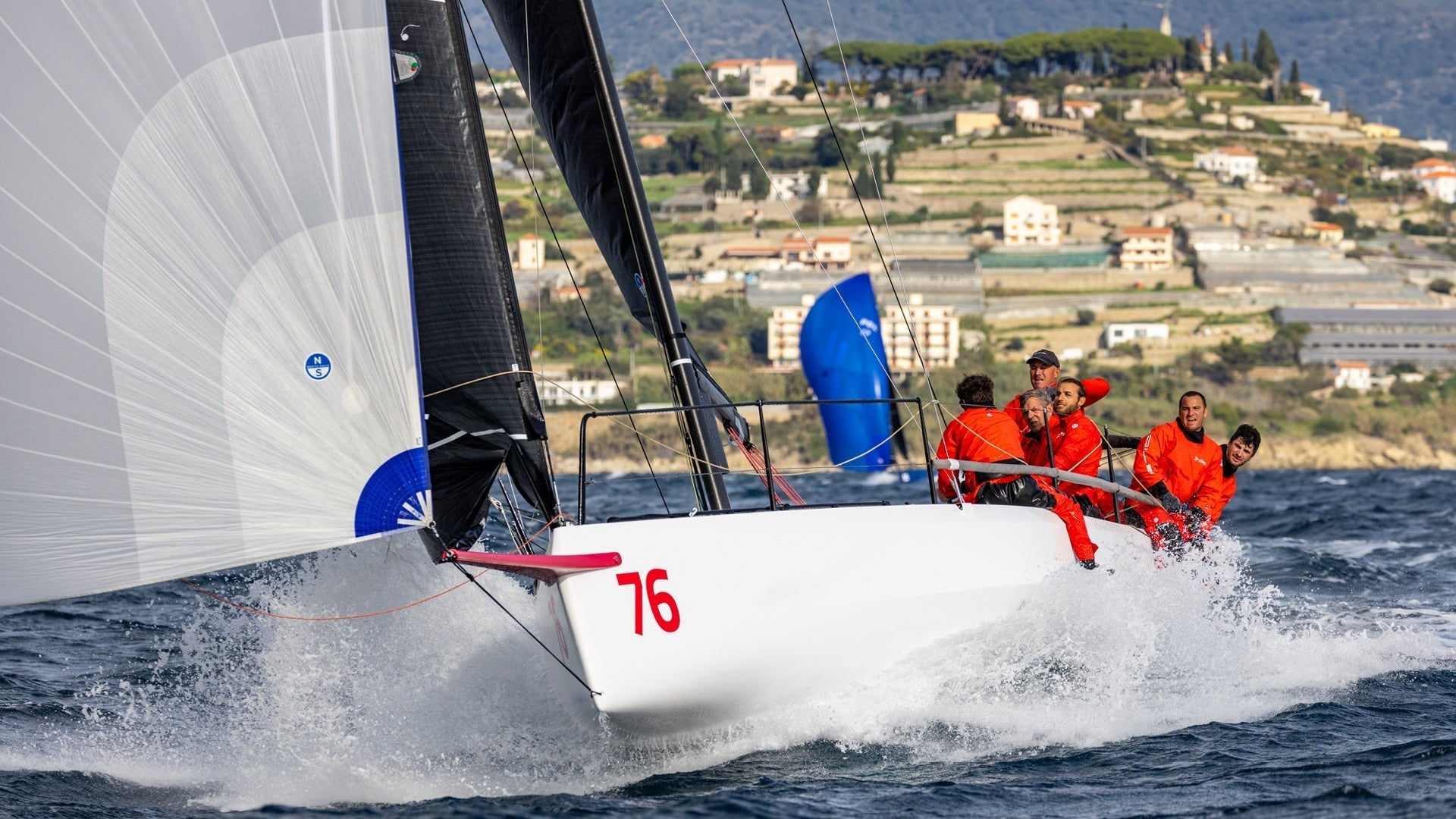LIGHTNING TUNING GUIDE
Proper boat speed depends mostly on constant and consistent adjustments to your rig and sails. The following measurements are those we have found to be the fastest settings for your new North Sails. We have included information on both the tuning of the M-5 and the MF-2 design sails. The M-5 is a more backstay sensitive sail, which sails fastest when the blocks and the lower shrouds are adjusted corresponding to the change in conditions. The MF-2 mainsail responds best to mainsheet tension with less emphasis on adjustment to the backstay, the blocks and the lower shrouds. Both tuning techniques have proven to be very fast and we’re confident that through following the basic numbers we offer in this tuning guide you’ll find top speed in all conditions. However, as always, your North Lightning team is anxious to help you any way we can. Feel free to call or email us anytime! Good luck and good sailing! In our new tuning guide we have divided the MF-2 and the M-5 tuning procedures.
Note that the techniques used in setting both systems are quite different. Please check it over carefully! All of your North Lightning representatives are comfortable with the tuning for both techniques. Should you have any questions about either style, we urge you to call us. We are always happy to help.
THE STEPS IN TUNING
The tools necessary for properly tuning your boat are a 50 foot tape measure, the black Loos tension gauge (PT-1) and a permanent marker.

Note: The newer PT-1 black spring- loaded Loos gauge is very consistent and works great for checking the shroud tension on your uppers and lowers. Because of this we now use the PT-1 gauge for both tuning methods.
MARK YOUR HEADSTAY
Lay the forestay along the front of the mast and mark where it is even with the top of the mast band at the gooseneck. This can be accomplished with the mast on the ground or stepped with the uppers attached.

MAST STEP POSITION
For the M-5 Tuning System we suggest placing the butt of the mast at maximum forward (the aft edge of the butt of the mast should be 21 5/8” forward of the center of the centerboard pin). For the MF-2 Tuning System and for Allen boats we suggest placing the butt at maximum forward. For the Nickels Boats (both the newer (after 15200) and older) we suggest moving the butt aft one hole in the channel. For any boat having difficulty developing the proper prebend (or with the upper shrouds further aft (such as the Carson or Lippincott) we suggest moving the butt of the mast aft as much as 3/8” to 5/8”. For the Carson and Lippincott hulls the butt measurement should be only 20 1/4” forward of the pin.
ADJUST THE HEAD-STAY LENGTH
Hook up your headstay and measure from your mark that was determined in Step 1 of the tuning guide to the intersection of the stem and the deck.
|
Headstay Table |
||
| M-5 |
Nickels |
44.5” |
|
|
Allen |
45” |
|
New Nickels |
45” |
|
|
MF-2 |
Nickels |
44” |
|
Allen |
44.5” |
|
|
New Nickels |
44.5” |
|
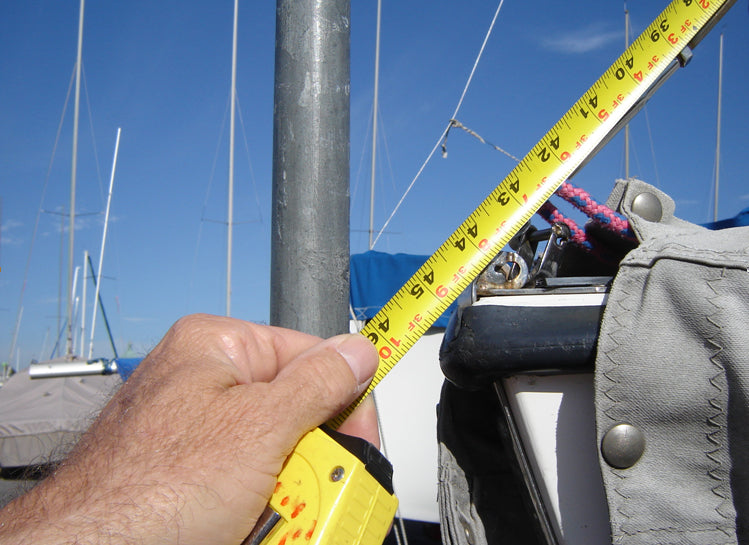
Measure from the top of the mark on your forestay to the joint of the bow and your deck to set your forestay length.
THE M-5 TUNING SYSTEM
INITIAL SET-UP
-
Allow your mast to lean fully back on the forestay with no shrouds attached or mast blocks in place. Mark your deck on both sides directly across from the front or back of the mast. You can put in the side blocks and use the aft edge to make your reference mark clearer. This is your “0” datum point.
-
Place marks at ¾”, 1”, 1 ¼” and 1 ½” forward of the datum. These will be references for block position.
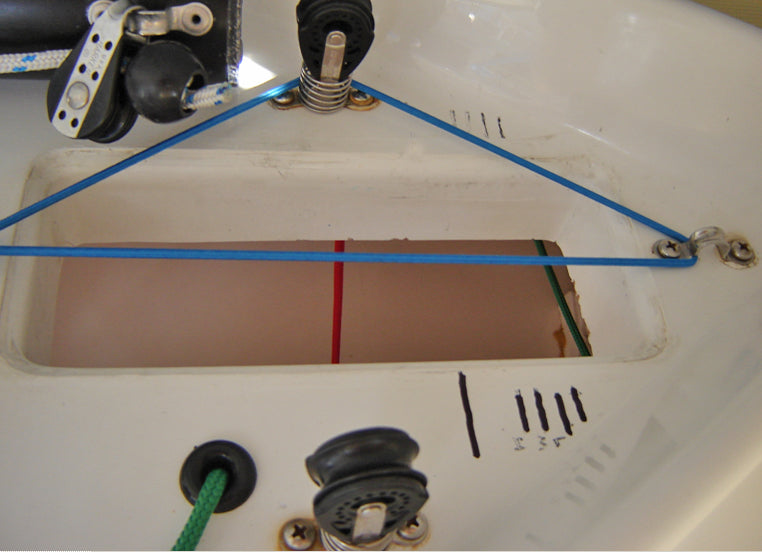
-
Attach your upper shrouds to the forward chain plates and tension them to the class maximum of 250 pounds. Do not attach the lowers or be sure that they are very loose.
Note: It is important that the mast is straight in the boat and not leaning or bowing to either side. To verify this, hook a tape measure to the jib halyard. Measure to the chine below the upper chainplate on each of the boat. This measurement should be within 1/4” on each side and can be adjusted by adjusting the turnbuckles on either side. -
Attach the lower shrouds to the aft chainplates and tighten them until they are just barely hand tight. Check that the mast is still straight laterally by sighting up the back of the mast. This adjustment to the lower shrouds is just initial tuning and will be adjusted later once the blocks are placed at the partners.
M-5 BASE SETUP (2 on rail-starting to hike)
-
Place your mast blocks behind your mast until the mast is 1 1/4” forward of your 0 datum point. This is base blocking.
-
Pull your backstay until the forestay just registers “7” (using the Black PT-1 Loos tension gauge).
-
Adjust your lower shrouds equally until they are “11” on the Black PT-1 Loos gauge.
-
Sight the mast to make sure it is still straight. Adjust the lowers if needed to straighten (ie. 1 off and 1 on, until it is straight)
M-5 TUNING MATRIX
This tuning matrix eliminates some variables by referencing power in the boat instead of wind speeds. For each change in power, you’ll adjust the lowers or the blocking and sometimes both.
|
Wind |
Turns on Lowers |
Mast Blocking |
PT-1 Tension |
# Turns from Base |
|
0-5 "drifter" |
-1 |
1 1/2" |
varies |
-2 |
|
Light-2 in boat |
-1 |
1 1/4" |
varies |
-1 |
|
2 on rail-starting to hike |
Base |
1 1/4" |
11 |
0 |
|
3 up-Fully hiking |
1 |
1 1/4" |
18 |
1 |
|
Fully-hiking-Backstay coming on |
1 |
1 1/4" |
20 |
2 |
|
Depowering |
0.5 |
1 1/8" |
20 |
2.5 |
|
Maximum depowering |
1(or 1.5) |
1" |
21 |
3.5 (or 4) |
|
Main starting to luff |
1.5 |
3/4" |
28 |
5 |
*Lower tension PT-1 gauge. Pull backstay to make headstay 7
The mast blocking and lower tension go hand in hand to properly set up the sails. The blocking controls lower mast bend, stiffening or softening the mast. The lower tension controls, or allows mast bend and poke or sag at the spreaders.
In light air we need to prebend the mast. If the mast were too straight, the front of the main would be too deep (drag) and the jib couldn’t be trimmed. So, we block forward (blocks behind the mast), softening the mast and bending it down low. The lowers are also eased to let the middle of the mast go forward. Both actions contribute to a looser headstay, powering up the jib.
As it gets windier and we start pulling on the backstay, we need to straighten and stiffen the mast. Without tightening the lowers, or blocking aft, the mast would bend too much creating overbend wrinkles (from the middle of the mast towards the clew) taking the shape out of the sail. So, we block back (blocks in front of the mast) which reduces lower mast bend and stiffens that section. We also tighten the lowers which will restrict mast bend at the spreaders. Now when the backstay is tensioned to reduce power, the bottom of the main doesn’t over-flatten, the top of the sail gets flatter, and the headstay is tightened.
Note: Without the proper backstay tension in light winds the mast will lean much too far forward and there will be too much headstay sag. An overabundance of jib luff sag will result in the jib leech hitting the spreader and the shroud no matter how it is trimmed. The backstay is just tensioned to remove enough sag to keep the jib leech off the spreader and the shroud when the upper batten is angling just at the end of the spreader.
THE MF-2 TUNING SYSTEM
-
Set your upper shrouds at 250 lb. Tension with the lower shrouds tensioned to 80lbs.
Note: Important!!
This initial shroud setting is different from the Lightning Class maximum shroud tension measurement. Be sure to set the uppers at 250 while the lowers are set at approximately 80lbs. -
Push the mast forward in the partners and place nearly all your mast blocks behind the mast until the lower shrouds read close to 250-300lbs. It will require a great deal of pressure to push the mast far enough forward to induce the necessary 1 3/4” to 2” of positive prebend in the mast at the spreaders. To check this, pull your main halyard down and hold it up against the back of the mast at the gooseneck. The distance from the taught halyard wire to the back of the mast at the spreaders should be very close to 1 3/4”.

Usually a 1/2” block will be in place in front of the mast with the New Allen and New Nickels boats.
Note: With the later model Nickels and Allen boats usually the proper prebend will be reached while a ½” block is placed in front of the mast at the deck. On the Allen and newer Nickels the lower shrouds will read 300 lbs when set properly to achieve the necessary prebend. For the older Nickels and boats with the upper shrouds aft the lowers will be tensioned to 250lbs.
3. Verify that your lower shroud tension has now increased to 250-300 pounds. If your lower shroud tension is too light, chances are you will not induce the proper prebend. Increasing the lower tension will help achieve the prebend. At this point, because the mast has hopefully developed the prebend discussed above, the upper shrouds will drop in tension to 160-190lbs.
Note: Important!!
Do not re-tighten the uppers above 190lbs. This reduced tension is necessary for proper mast bend and is indicative that you’ve developed proper prebend.
Note: It is important that the mast is straight in the boat and not leaning or bowing to either side. To verify this, hook a tape measure to the jib halyard. Measure to the chine below the upper chainplate on each of the boat. This measurement should be within 1/4” on each side and can be adjusted by adjusting the turnbuckles on either side.
4. Hoist your 50’ tape measure on the main halyard and latch it in your lock. Check the measurement from the top of the mast to the intersection of the transom and the rear deck without the jib up but the proper prebend and rig tension as indicated above. Do not pull hard on the tape- take the measurement with the rig “relaxed. The rake should be close to 26’ 7” for the Allen and newer Nickels Boats. For the older Nickels the rake should be 26’6”. For the Lippincott/Carson boats this number should be at 26’ 3” to 26’ 4”.
Note: If your rake measurement is farther forward than the numbers listed above (more than l/2”), then consider pulling a small mast block ( ¼” increment) from behind the mast and re-tensioning the lowers to 250 pounds. Replace the block at the front of your mast and recheck that your prebend is the necessary 1 3/4”. Your mast should also have raked farther aft so that the rake number is smaller.
5. Without applying tension on the tape measure ( as described above) record the measurement at the transom. Now grab the backstay and pull until the slop in the forestay is just barely eliminated (not when the Loos gauge reads “O”). The change in your rake from the backstay pulled on to the backstay relaxed should be 3” to 4”. If this measurement is more than 4”, pull a small block from behind the mast and retention the lowers to 250-300 pounds (as described above). If the “rake change number” is less than 3”, place another small block behind the mast and ease the lowers off until they read the proper tension. This will allow the entire mast to tilt (rake) slightly farther forward.
6. Re-check your lower shroud tension side to side by sighting up the back of the mast to be sure the mast is perfectly straight laterally. Loosen and tighten the opposing sides until the mast is straight from the deck to the hounds, always maintaining the proper lower tension and prebend.
Once on the water double check your lateral straightness once again when sailing upwind in an 8-10 m.p.h. breeze.
Note: In breeze above 10-12 mph the upper sections of the mast above the spreader will fall off slightly sag to leeward. This is normal.
CONGRATULATIONS! You have completed all the tuning with the MF-2 setup. You will never need to adjust your lower shrouds or blocks until you take your mast down. When re stepping simply place everything back where you had it last!
JIB TRIM
JIB HALYARD TENSION
5A+ and V17+
Generally, set your jib halyard tension so that the jib luff wire (in the front of the jib) is just equal tension wise with the forestay when sailing upwind (There should be no sag in between the snaps.).
JF-2 and RJF
In all conditions set the jib halyard tension so that the luff wire is just slightly tighter than the forestay in all conditions. The forestay will show a slight “snake” between the snaps. From light to heavy winds this will mean an adjustment of nearly 2 1/2”. In very heavy winds jib halyard stretch will make it difficult to set the halyard tighter than the forestay. More tension on the halyard will be necessary.
JIB CLOTH TENSION
FOR ALL JIBS
In light winds the cloth tension will be set loose enough that there may be slight wrinkles along the luff. As the breeze increases, increase the cloth tension until all the wrinkles are barely removed in heavy wind. In very heavy winds pull the jib cloth tension a little tighter than just barely removing the wrinkles to flatten the sail and help open the upper batten.
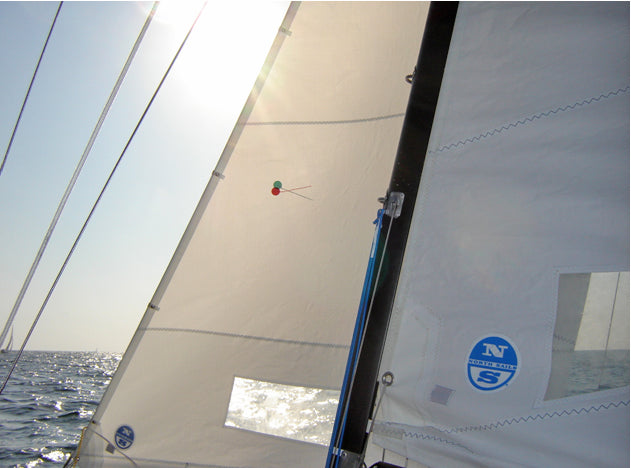
LASHING AT THE HEAD OF THE JIB
Each North jib has the luff wire attached to the head of the jib with a light line lashing which allows the height of the jib to be adjusted on the luff wire. Depending on the type of tack fitting on your boat, you may want to adjust this lashing to raise or lower the jib to sit on the deck properly. If the skirt of the jib is not laying on the deck approximately 1 1/2” to 2” (or the jib tack is higher than 3 1/2” off the deck) you may want to loosen the lashing and allow the jib to slide down closer to the deck. Be sure to tie well, or even tape, the lashing when done to prevent the lashing from coming untied.

JIB LEAD POSITION
Your North jibs are marked with a trim line near the clew drawn from the clew grommet toward the body of the sail. Your lead should be positioned so that the sheet is a direct extension of this trim line. This is more effective than a measurement from the stem to the lead position because of the variances in jib lead fittings and placement, rake, and jib wire height off the deck. Generally, you should set the lead in this direct extension position unless the boat is overpowered when the lead may be moved aft as much as 2”.

JIB SHEET TENSION
Normal jib sheet trim for 8 - 12 m.p.h. and flat water for the 5-A+ and the JF-2 jibs would be 2” - 3” inside the spreader tip. The V17+ tends to allow for a bit tighter sheeting. In winds below 8 m.p.h. or when trying to accelerate, leaving a tack, etc., the sheet will be progressively eased out until the top batten is angled even out past the end of the spreader. In extremely light winds it is advantageous to hold the clew of the jib up so the upper batten angles 1” outboard of the tip of the spreader. In heavy winds above 15, it may be necessary to ease the jib sheet to the point where the batten might be angled 1” or more past the end of the spreader. However, with any jib, in any condition, the best final check on jib sheet trim is that the jib leech telltale is flowing all the time. To aid in setting up the trim for your North jibs, we suggest placing rings of tape on your spreaders 2” and 4“ in from the tips of the spreaders.

Mark your spreader as a reference for jib trim, BUT check that the telltale on the leech at the top batten is always streaming.
MAINSAIL TRIM
MAINSAIL OUTHAUL
Your North mainsail is constructed with a shelf foot. Judge the outhaul tension at the center of the boom. The seam which attaches the shelf foot to the sail, the bottom seam in the sail) gets closer to the boom when the outhaul is tensioned or further away from the boom when the outhaul is eased. At maximum outhaul tension this seam will lay next to the boom and the shelf foot is closed. This is proper trim for heavy winds when the boat is overpowered. In light winds the center of this seam should be 1” to 2” from the boom. We do not feel it is advantageous to loosen the outhaul more than this when sailing upwind. Downwind loosen the outhaul to allow the shelf foot to open completely. This should place the clew of the main nearly 3” in from the band at the end of the boom.

Use the shelf foot seam as a guide for outhaul tension.
CUNNINGHAM TENSION
In light winds the MF-2 mainsail performs best with the cunningham completely slack. There should be nearly 8” wrinkles perpendicular to the luff from head to tack. On the M-5, the cunningham will be tensioned so that wrinkles are only evident below the spreader window.
In medium winds the cunningham should be tensioned on both mains so that wrinkles are evident just in the bottom of the mainsail below the spreader window. In heavy winds, it is beneficial to pull in the cunningham fairly aggressively. While the backstay is applied to de-power the main, the cunningham should be pulled on to maintain the proper draft position.

BACKSTAY
The backstay controls mast bend and headstay sag. Pulling it harder flattens both the main and the jib. It also changes the main leech tension and the angle of the upper batten of the main. In very light winds when the mast is blocked forward and pre-bent (see mast blocking) tension the backstay slightly to keep the headstay from sagging (and bouncing) too much. In heavy air more backstay is necessary to flatten the main. If you pull the backstay too hard, the main will invert as evidenced by large diagonal wrinkles running from the upper area of the main above the spreaders down towards the clew.
In medium to heavy winds, some inversion wrinkles below the spreader window are normal and desirable as they indicate that maximum mast bend has been achieved.

Ideally, overbend wrinkles will fall just below the spreader window and halfway back on the boom when proper prebend and mast bend is achieved.
As a basic guide, for the mainsail to take shape and the upper batten to be trimmed parallel to the boom (see mainsheet trim), the backstay should be applied to just barely remove the slop. Once all three crew are on the high side and beginning to hike, the backstay should be tensioned much more tightly. As the boat hits waves or sails into lulls, be sure to ease the backstay to power the rig back up. It is also important to remember that as you pull on more backstay you must also pull on a proportionate amount of both jib cloth and main cunningham. These three controls working in harmony are the best way to keep your sails performing at their designed best shape.
THE MAIN BRIDLE AND TRAVELER
If you have a bridle that is adjustable in height, it is advantageous to raise the bridle for light winds so when the main is sheeted properly (upper batten parallel to the boom), the top of the bridle block should be close to the block on the end of the boom. This will bring the boom to center when the mainsheet is trimmed. In medium winds above 6-8 mph, the bridle should be approximately 11” to 12” above the deck; in heavy winds, the bridle should only be 9” above the deck. If your bridle is not adjustable, set it at 11” off the deck. The traveler is normally centered for light to medium winds, but as the boat starts to heel and becomes overpowered, and therefore develops more helm, the traveler should be eased to leeward. Do not ease the traveler to leeward until the outhaul is fully tensioned and moderate tension has been applied to the backstay. Often, it pays to moderately depower with the backstay, outhaul and Cunningham before easing the traveler.

MAINSHEET TENSION
The general rule is to trim the mainsheet to maintain the top batten parallel to the boom. This is viewed by sighting directly underneath the boom up towards the upper batten. When power is necessary in light or choppy conditions or just after a tack it is important that the mainsheet is eased so that the upper batten is angled outboard (10 - 15°) from parallel to the boom.
Once up to speed, re-trim the main to upper batten parallel. In heavy winds, when maximum backstay tension is applied and the main is fairly flat, the upper batten will angle slightly outboard in relation to the boom. In drifting conditions where the weight of the boom will hook the upper batten, ease the mainsheet until the upper batten is parallel to the center line of the boat. The boom will be positioned well to leeward of center line, as much as 18”. Be sure to recheck the top batten position whenever the backstay and Cunningham are adjusted. Consider the mainsheet your throttle. It helps to keep the mainsheet in hand and play it to keep the boat moving. When it starts to feel slow, ease the sheet and when it feels fast try trimming in tighter to increase pointing ability. In other words, if it feels good, pull! When it feels ugly, ease it out. Upwind in heavy air or very puffy conditions with the MF-2 Main, the boom vang is tensioned so the mainsheet can be played like a traveler. Tension the vang in these conditions so the upper batten is angled outboard 10°. With this proper necessary tension, the boom may actually show a bit of bend. Play your mainsheet to keep the boat flat and the helm balanced! Be sure to ease your vang as you round the weather mark! With the M-5 Main, most of the main control is accomplished with careful balance between the mainsheet and traveler. However, some sailors have had success tensioning the vang just to point where the boom will not raise up when the main sheet is eased. With any “style” of mainsheet trimming you choose to sail with upwind it is imperative that in puffs the boat remains flat, stable and the helm balanced. Quick and deliberate adjustments to the mainsheet, vang, backstay and traveler are important. Adjust quickly but re-trim just as quickly after sailing through the puff and the boat is back under control and balanced.

BOOM VANG TENSION DOWNWIND
The boom vang is used downwind to maintain the upper batten nearly parallel to the boom. Be conscious of not over- tensioning the vang, especially in light winds, as it can greatly slow the Lightning when sailing downwind. In puffs while reaching, when the boat becomes overpowered, try dumping the vang (completely eased) to keep the end of the boom from hitting the water and allow the top of the main to luff, dumping extra power.
THE SPINNAKER

Trimming your North spinnaker is fairly easy as long as you follow a few guidelines. Always attempt to fly your spinnaker so there is nearly 6” of curl in the luff. This is important so the spinnaker is not over trimmed and does not choke the slot between the spinnaker and the main. We suggest flying your spinnaker with the halyard eased approximately 6” off the mast to open the slot up high. Always keep your clews even through adjustment to your pole topping lift. When your leeward clew is hidden behind the main and you cannot see it, keep the center seam of the spinnaker parallel to the mast. In puffy conditions, especially in lighter winds, constant adjustment of the pole height along with the sheet and guy is important. Keep the pole nearly perpendicular to the wind.
SAIL CARE
The sun is one of your sail’s greatest enemies. Care should be taken to not leave an uncovered sail directly in UV light for long periods. Spinnakers are most susceptible to UV damage. However, your sail’s greatest enemy is prolonged luffing. Putting your sails up before you are ready to leave the dock and allowing them to flog unnecessarily, literally wastes valuable hours and days of the competitive life of your sails. Even before the start on a breezy day, try to spend as little time as possible with the jib up and luffing to save wear and tear. The jib especially takes a beating when luffing as it slams back and forth against the mast. This breaks down the resin in the weave of the cloth. When finished using your sails, even after just a couple races or in-between races, we strongly suggest taking the time to roll up your sail parallel to the battens (it is never necessary to remove the battens). Be careful not to set anything heavy that can crush a sail or to lash the main too tight on to the boom. Be sure to roll the sail parallel to the battens to avoid putting a permanent twist in your special tapered fiberglass battens. Fold your spinnaker to keep it smooth before storing. When sailing in saltwater, be sure to wash all your sails off completely with fresh water and dry completely before storing them. Check all your sails, especially at the front and back of batten pockets and around grommets for signs of wear. Check your spinnaker for tears, so they don’t get bigger and create big problems in the future. If Dacron sail tape is not available, duct tape will work just fine!







